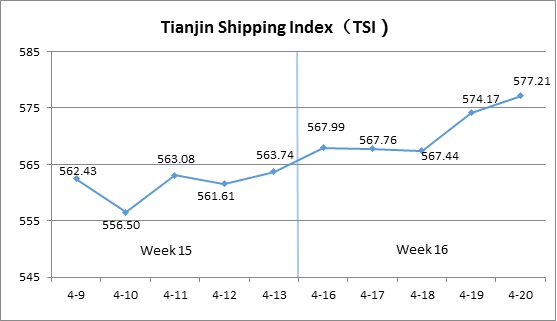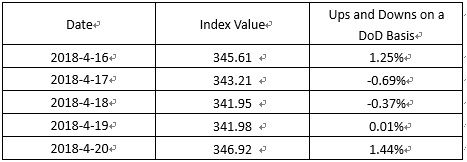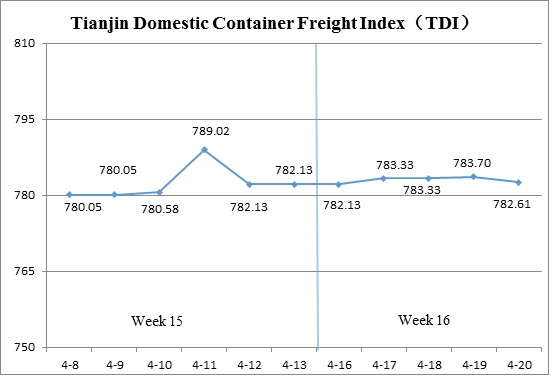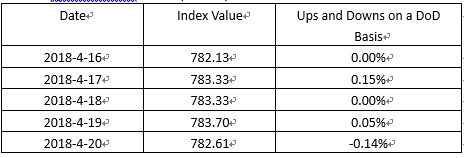Tianjin Shipping Index (Apr.16-Apr.20)
I. Tianjin Shipping Index (TSI)
In Week 16 2018 (Apr.16-Apr.20), Tianjin Container Freight Index (TCI) increased with fluctuation. Tianjin Bulk Freight Index (TBI) kept increasing. Tianjin Domestic Container Freight Index (TDI) increased slightly. Tianjin Shipping Index (TSI) increased markedly. The TSI closed at 577.21 points with an increase of 2.39% from Apr.13 (the last release day of Week 15). The TSI trend is as follows:

The chart above shows the trends of TSI from Apr.9 to Apr.20. The value of TSI in Week 16, 2018 is as follows:

II. Tianjin Container Freight Index (TCI)
In Week 16 2018 (Apr.16 to Apr.20), the trend of TCI is as follows:

In week 16, the TCI increased slightly with shocks.
From Apr.16 to Apr. 18 (Mon. To Wed.), the freight rates in North American route and South American route increased overall. The freight rates in Persian-Gulf route increased with shocks. The freight rates in European route and Mediterranean route decreased slightly. The TCI increased and then decreased by 0.18% on three consecutive release days. From Apr.19 to Apr.20(Thu. to Fri.),the freight rates in European route, Mediterranean route and North American route kept stable. The freight rates in South American route decreased. The freight rates in Persian-Gulf route kept the increase trend. The TCI kept increasing by 1.45% on two consecutive release days.
The TCI closed at 346.92 points with an increase of 5.58 points (1.63%) from Apr.13 (the last release day of Week 15).
The TCI index value saw several up and down on a day-on-day basis are as follows:

European/Mediterranean route Cargo volume presented a weak trend. Transport capacity remained a high level. Because the freight rates decreased for over 50 percent since Spring Festival, the ship owners’ willingness to reduce the freight rates was inadequate. The freight rates decreased much slower. The freight indices in European route, Mediterranean East route and Mediterranean West route decreased 3.24%, 2.09% and 4.89% on a week on week basis.
North American route Recently, the ship owners put new ships on the market. The “small for bigger” strategy influenced the transport capacity and the freight rates kept decreasing. Pressured by cost, some shipping alliances tried to raise the freight rates which presented an increase trend. The freight indices in North American West Coast route and North American East Coast route increased 2.70% and 1.43%.
South American route Cargo volume stabilized and increased. Shipping companies carried out the freight-rate-rising plan this month. The freight rates increased overall. The GRI was decreased for loading rate in later half of the week. Since 2018, the freight rates in South American West Coast route decreased for nearly 70 percent. The increase was fastest this week. The freight indices increased 44.64% on a week on week basis. In comparison, the freight rates in South American East route and Central South American route increased slightly. The freight indices increased 2.65% and 7.72% on a week on week basis.
Persian-Gulf route With the coming of Ramadan, some shipping alliances raised the freight rates to maintain operating earning rate. This week, other ship owners followed their steps to raise the freight rates. The freight indices increased 16.87% on a week on week basis.
III. Tianjin Bulk Freight Index (TBI)
Week 16, 2018 (Apr.16 – Apr.20), Tianjin Bulk Freight Index (TBI) is shown as follows:

In week 16, the TBI increased continuously and the increase extended later in the week.
From Apr.16 to Apr.18 (Mon. to Wed.), the freight rates of coal and grain shocked narrowly and the freight rate of mineral ore increased slightly, which led the TBI to increase for three successive release days and the total increase was 1.29%. Then, the freight rates of coal and grain decreased slightly and the increase of the freight rate of mineral ore extended, which led the TBI to increase form Apr.19 to Apr.20 (Thu. to Fri.) and the total increase was 3.33%.
TBI ended at 774.20 points with an increase of 34.47 points (4.66%) from Apr.13 (the last release day of week 15).
TBI index value saw several ups and downs on a day-on-day basis, which is shown as follows:

TBCI decreased with shocks this week. TBCI ended at 584.53 points with a decrease of 10.45 points (1.76%) from Apr.13 (the last release day of week 15). Domestic coal demand decreased and the deal of coal in Australia was not active. The market was gloomy as a whole. For the Panamax market, available carriers were enough and the freight rate of the DBCT to Tianjin route decreased about 6%. For the Capesize market, with the influence of the market recovery, the freight rate of Hay Point to Qingdao route increased over 4.5%.
TBGI decreased slightly this week. It ended at 693.69 points with a decrease of 3.84 points (0.55%) from Apr.13 (the last release day of week 15). The market of the Panamax market was gloomy. Though the shipment of grain in South America was frequent, the freight rate of grain decreased slightly. The increase of carriers in ballast in the market in South America caused the freight rate of South America to Tianjin route decreased over 0.4%. By contrast, the freight rate of US Gulf to Tianjin route decreased over 0.7% and the freight rate of West America to Tianjin route decreased over 0.7%.
TBMI increased continuously and then rose sharply later this week . It ended at 1044.38 points with an increase of 117.70 points (12.70%) from Apr.13 (the last release day of week 15). For the iron ore market, it began to increase and the shipping market demand exceeds the supply in short terms. There is a strong willingness for ship owners’ to raise the freight rate,which increased rapidly. The shipment of Australian miners became active later and the oil price increased, which led the freight rate of West Australia to North China to increase about 14%. By contrast, due to the stressful shipping capacity, the freight rate of Brazil to Tianjin route increased about 21% this week. As for nickel ore, under the influence of weather, the shipment of nickel ore in the Philippines rose slightly this weekend. The freight rate of Surigao to Tianjin route increased over 0.6%.
IV. Tianjin Domestic Container Freight Index (TDI)
Week 16, 2018 (Apr.16-Apr.20), the trend of Tianjin Domestic Container Freight Index (TDI) is shown in the chart below:

The TDI in Week 16 first went up and then slid.
From Apr.16 (Mon.) to Apr.19 (Thur.), the Outward Index kept steady, and the TDI was mainly influenced by the Inward Index. The freight rate index of Guangzhou-Tianjin route rose twice this week, respectively on Apr.17 (Tues.) to Apr.19 (Thur.), driving the TDI increased slightly. On Apr.20 (Fri.), the Inward Index returned stability, the freight rate index of Tianjin-Quanzhou route went better, but that of Tianjin-Shanghai route declined, leading the TDI to decrease on a day-on-day basis (0.14%). The TDI rose 1.08% and hit the maximum on Apr.11 (Wed.). On Apr.12 (Thur.), the Outward Index continued rising, but the Inward Index started to decline, so the TDI decreased. Finally, the TDI closed at 782.61 points, with a growth of 0.48points (0.06%), compared with that on Apr.13 (the last release day of Week 15).
The value of TDI ups and downs on a day-on-day basis is shown as follows:

Tianjin Domestic Container Outward Freight Index (TDOI) suffered a slight decrease this week, eventually closing at 953.17 points on Apr.20 (Fri.), declining 2.18 points (0.23%) compared with that on Apr.13 (the last release day of Week 15). The freight rate indices of three routes differed this week. The freight rate index of Tianjin-Quanzhou rose 0.28%, because the ship owners continued pushing up the freight. That of Tianjin-Shanghai decreased 5.56% because the supply surpassed the demand. By contrast, that of Tianjin-Guangzhou route kept stable.
Tianjin Domestic Container Inward Freight Index (TDII) increased a little. It closed at 612.05 points on Apr.20, with an increase of 3.14 points (0.52%), compared with that on Apr.13(the last release day of Week 15). This week, the freight rate index of Quanzhou-Tianjin route and that of Shanghai-Tianjin route remained stable this week. By contrast, that of Guangzhou -Tianjin started to rise (0.76%).
HEADLINES
- Do shipping markets want Biden or Trump for the win?
- All 18 crew safe after fire on Japanese-owned tanker off Singapore
- Singapore launching $44m co-investment initiative for maritime tech start-ups
- Cosco debuts Global Shipping Industry Chain Cooperation Initiative
- US warns of more shipping sanctions
- China continues seaport consolidation as Dalian offer goes unconditional